“Oi mate, yer bike’s on fire!”
The shout from the taxi driver who’d pulled up alongside me at traffic lights in west London made me look down at the ageing CB250 whose throttle I was desperately revving in an attempt to prevent the engine from conking out.
The cabbie was right. Thick smoke was belching out behind me from a twin-cylinder motor that had been running increasingly badly, and now looked and sounded as though it was about to explode.
With a heavy heart I waited for the lights to change, then eased the gold-coloured Honda off the road and let its motor die, wondering how I had been foolish enough to get involved with such an unreliable heap in the first place. And more urgently, how the hell I was going to get home.
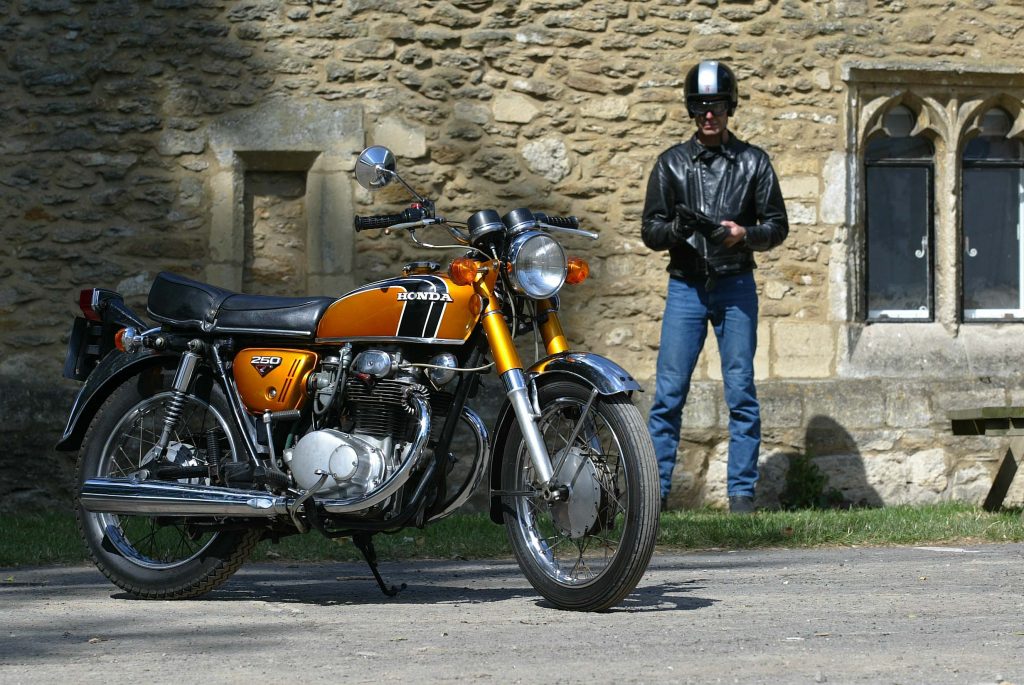
At this point I should add that the above scenario happened to my own shabby CB250, more than 40 years ago, not to the clean and well-behaved machine pictured (which was borrowed from Japanese classic specialists Oxford Classic Honda). That smoky incident, the result of poor maintenance, was unrepresentative of the CB250, which was one of the models that helped Honda establish its reputation for reliability and high-quality engineering in the early Seventies.
Although the CB250 parallel twin couldn’t match the performance or glamour of Honda’s fours – or of its 250cc two-stroke rivals from Suzuki and Yamaha – it was one of the firm’s most popular and long-lasting models. The CB, after all, was a direct descendent of the sporty 250cc CB72 of the early Sixties, which had first shown that Honda could build exciting bikes rather than just small-capacity commuter machines.
The CB250 had been introduced in 1968, as the sports model of a trio of twins, the others being the CD250 tourer and CL250 street scrambler. The new 249cc engine had oversquare dimensions of 56 x 50.6mm and was similar in many respects to earlier Honda units, including in its use of a single overhead camshaft with drive by a central chain, and a 180-degree crankshaft.
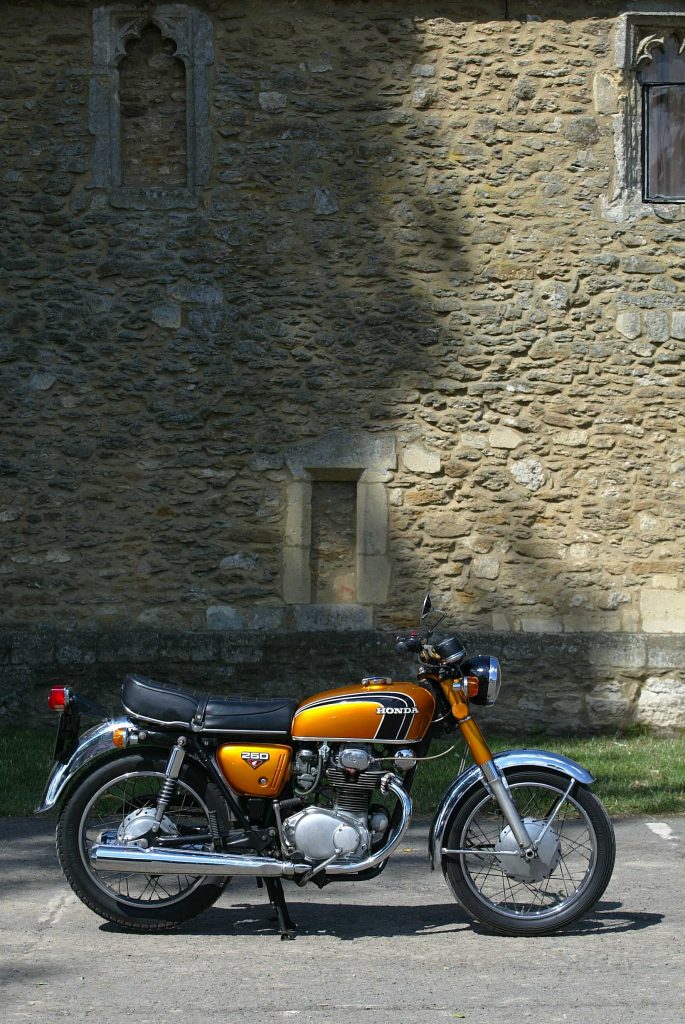
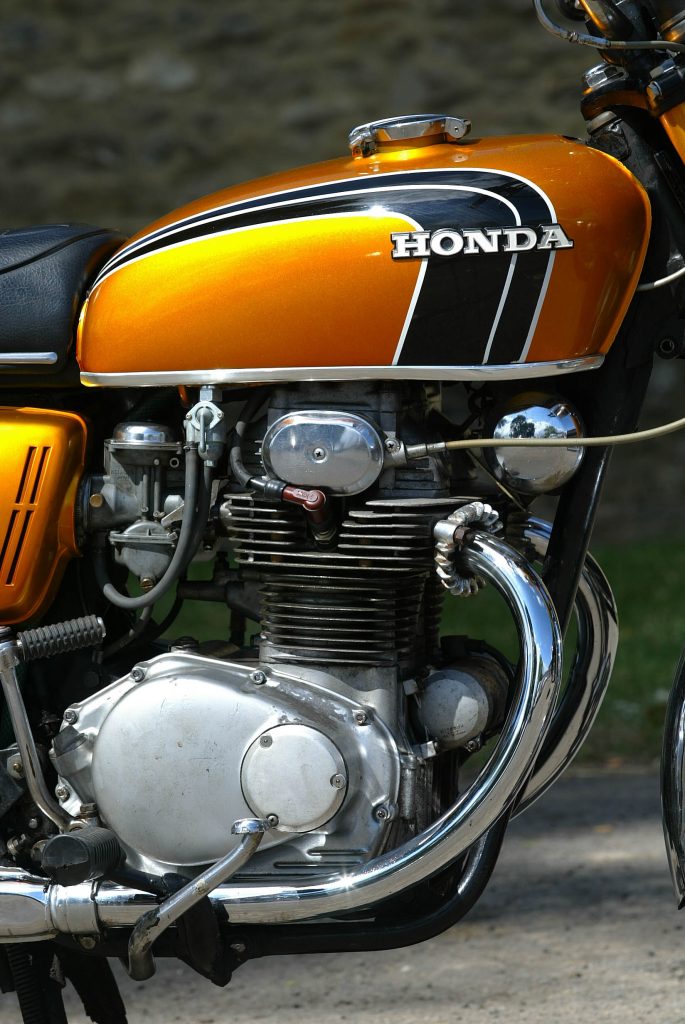
One key difference from Honda’s previous twins was that the new engine’s cylinders were set almost vertically, instead of angled forward as before. As the sporty model, the CB followed Honda tradition by having twin carburettors, which helped it produce a maximum of 30bhp at 10,500rpm, a few horses up on the 27bhp of its single-carb siblings. Both CB and CL had five-speed gearboxes; the CD made do with four.
The twin-cradle frame, which had a pressed steel spine under the tank, was similar on all three models. Even the suspension and wheels differed little, although the CL had gaiters for its forks. The CB was treated to a twin-leading-shoe front drum brake, instead of single-leading-shoe like the others, and also featured a rev-counter alongside its speedo.
Honda made few changes to the CB250 over the next few years, though the original 250K model’s petrol tank rubber knee-pads were dropped for the following year’s K1 model which, like the following K2, had a slightly more angular tank than the 1971-model K3. The most popular version in Britain was this model, the K4, which arrived in late 1971 and was sold in larger numbers during the following year, which was when this particular gold-coloured bike was first registered.
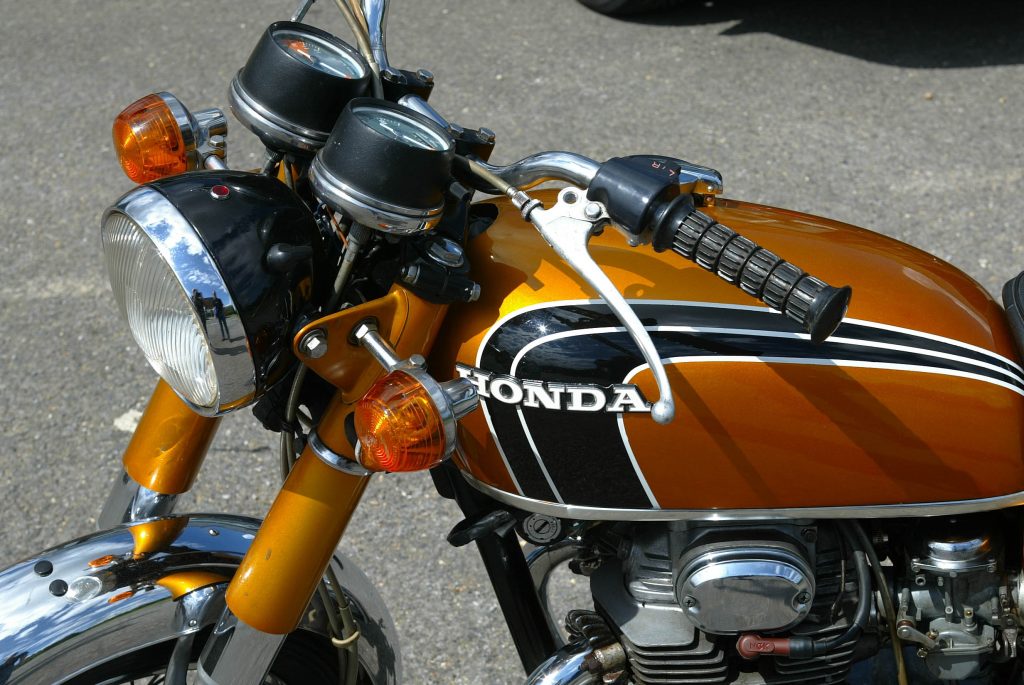
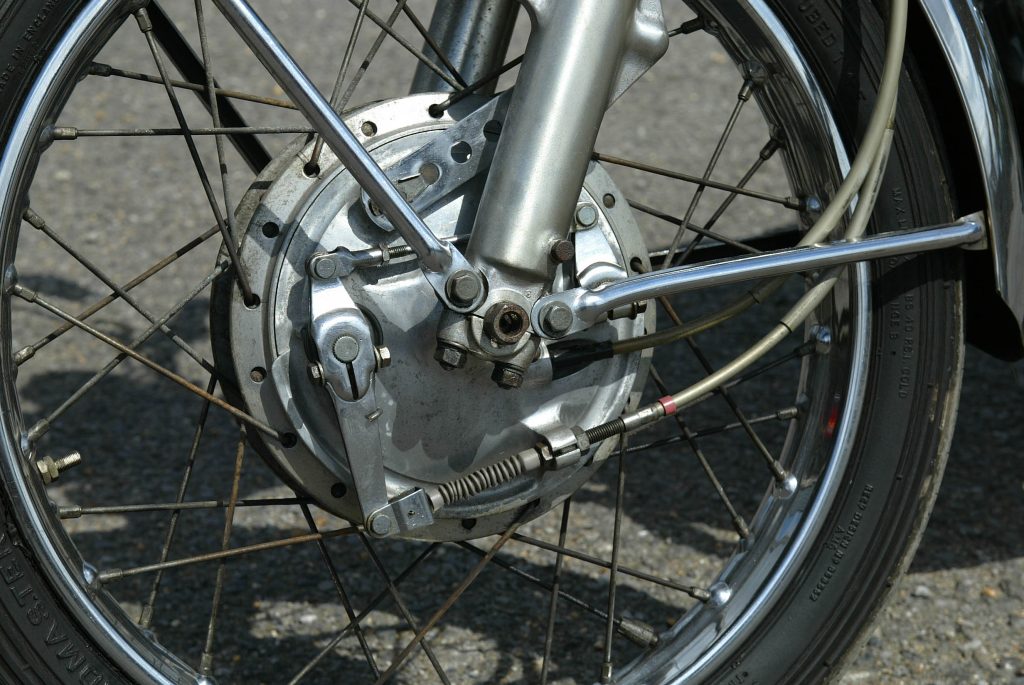
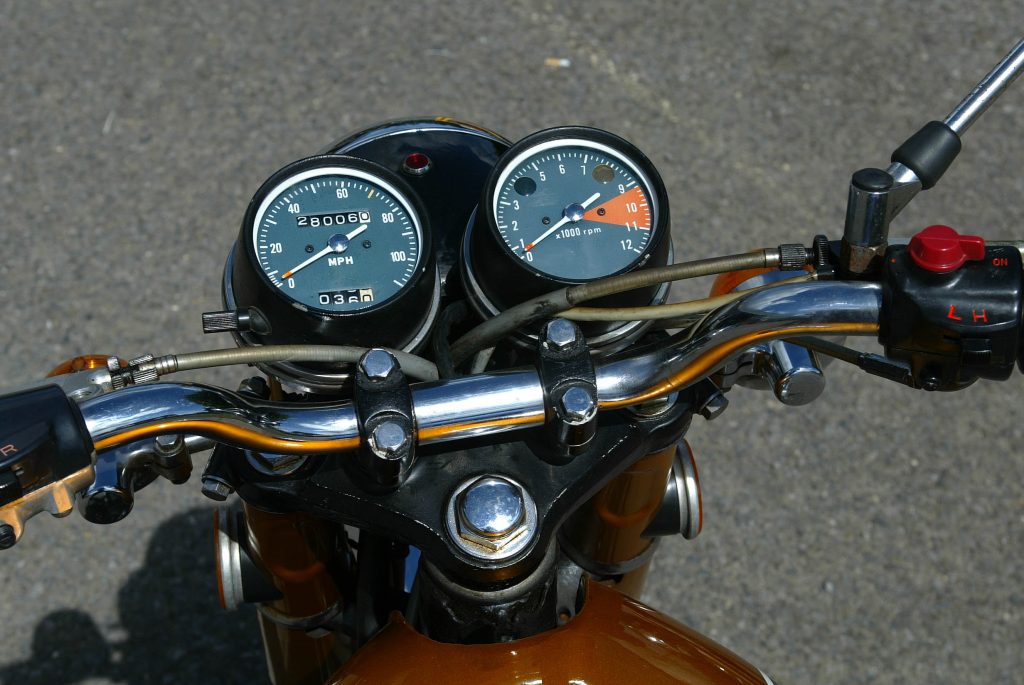
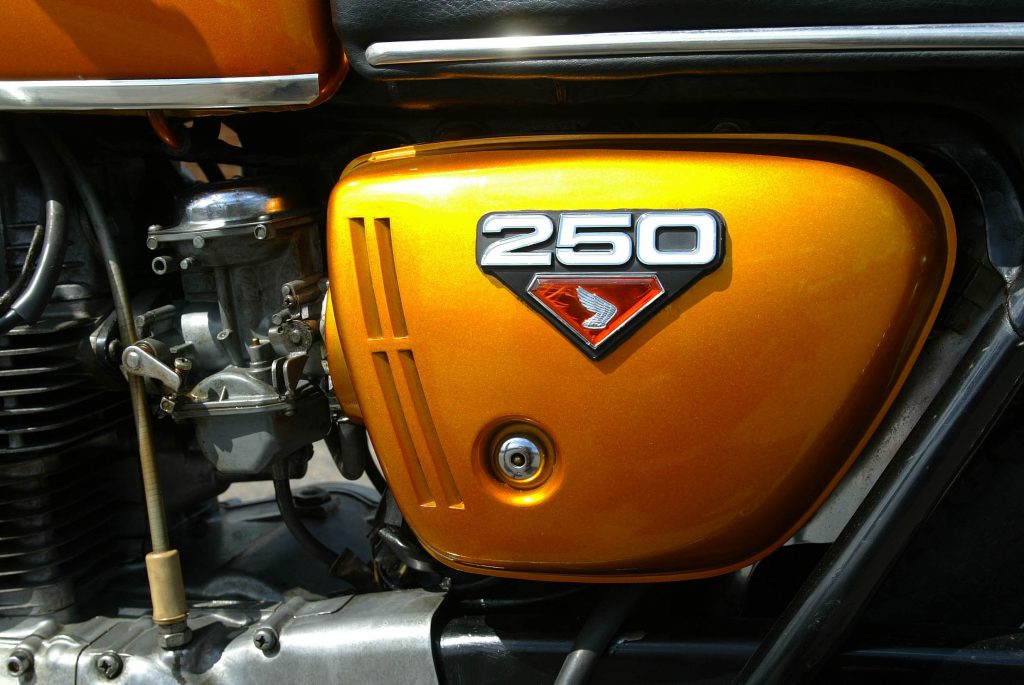
All those years ago I can remember being pretty impressed with my CB250’s speed, when it was running well. That was hardly surprising, as the bike I’d been riding before buying it was an SL125, with half the number of cylinders and horsepower.
“My” CB250 had previously given me a hugely entertaining moment when still owned by my mate Chris, whose dad had come out of the house for a look, and announced that he’d ridden motorbikes in his youth. The old boy proceeded to get on the Honda, rev it up and drop the clutch – at which point he shot across his garden, totally out of control, ending up under a hedge alongside the bike…
That old Honda never generated quite such excitement again, and nor did this one on my more recent ride, but the 30-horse twin was capable of a fair turn of speed. Its forebear the CB72 had been rumoured to be capable of 90mph on a good day, despite a claimed output of just 24bhp. Something didn’t quite add up, though, because American magazine Cycle World had managed exactly that top speed from the CB350, which at 36bhp was 6bhp more powerful than the lookalike CB250.
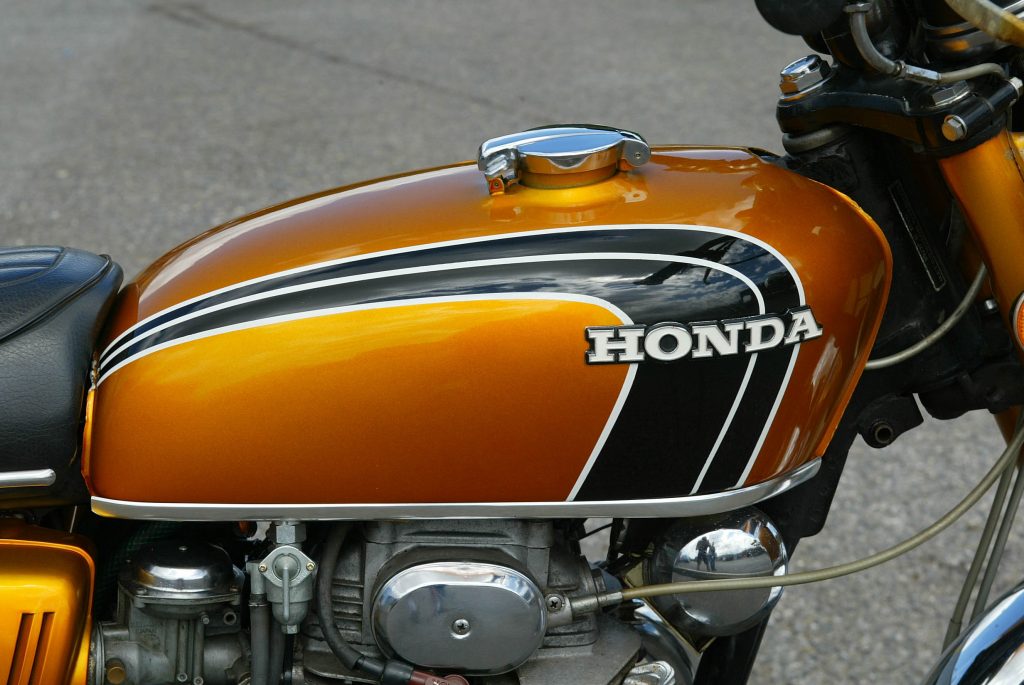
The CB250’s true top speed was probably about 85mph, although given my experiences with my own bike, I didn’t hold this one flat-out for long enough to check. Instead I spent much of the time cruising along at a gentle 55mph and about 6500rpm, at which speed the Honda felt very smooth, and still had some not-too-dramatic acceleration in hand.
Keeping the revs down meant missing out on acceleration, because the smaller motor liked to be revved. Or, as Bike magazine’s tester put it in 1972, “If you enjoy mixing it with the bigger boys, then you’ve got to grab that suicide handle and keep it cooking.” There wasn’t much power below 5000rpm, and to get the best out of the Honda you had to keep the tacho needle between 7000rpm and the red-line at 9200rpm.
I hadn’t expected too much of the handling, given the Honda’s age and relatively crude chassis design, but in fact it cornered respectably well and was stable at speed. I’d been wary of the old and cracked Avon tyres, but thankfully they still held the road respectably well. I enjoyed flicking through bends on a bike that weighed just 156kg, and felt fairly light and agile.
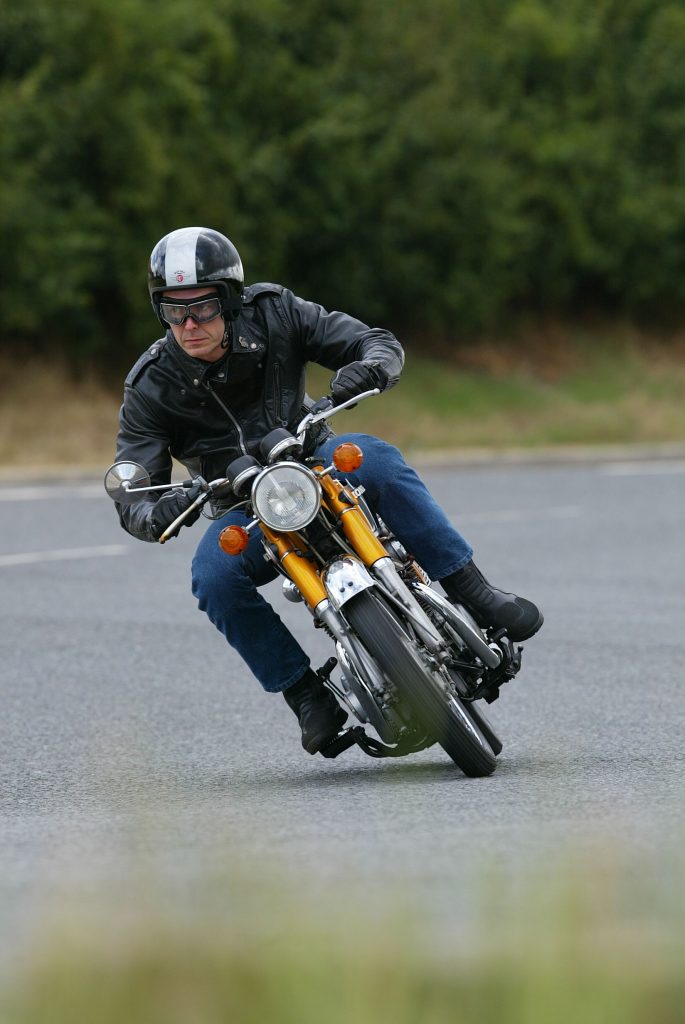
Suspension at both ends was slightly soft and vague, but pretty good considering its age and the fact that the CB250 had always been rated as highly for its comfort as for its handling. I was also pleasantly surprised by the brakes, especially the twin-leading-shoe front drum, which gave reasonably powerful stopping.
Despite that, Honda soon updated the CB with a disc front brake and six-speed gearbox. For 1977 it was revamped with slimmer styling and a two-into-one exhaust to create the CJ250T. That in turn was replaced a year later by the CB250T Dream, featuring a bulbous tank and new three-valves-per-cylinder engine.
The original, familiar CB250 was gone, but it would not be forgotten. Especially by any former owners who had suffered the shock of glancing down at the traffic lights to see their example of Honda’s fine engineering belching smoke and about to expire.
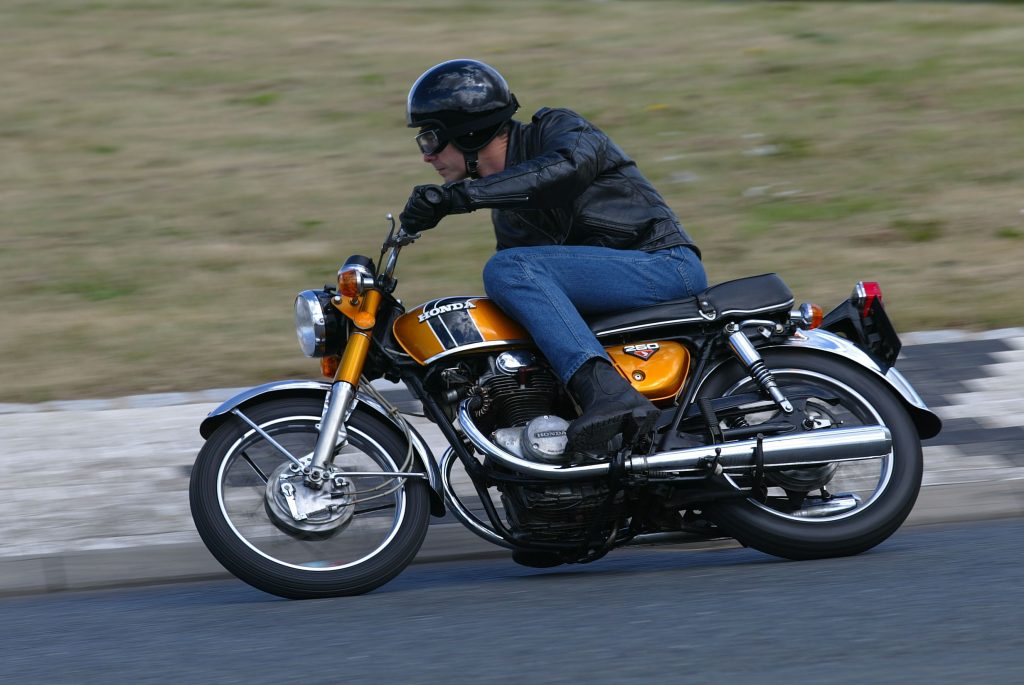
1972 Honda CB250K4
You’ll love: Its all-round performance and reliability… usually
You’ll curse: Any mechanical bodges by a previous owner
Buy it because: It’s fun to ride, has Seventies style and is great value
Condition and price range: Project: £2500 Nice ride: £3500 Showing off: £4500
Engine: Aircooled sohc parallel twin
Capacity: 249cc
Maximum power: 30bhp @ 10,500rpm
Weight: 156kg with fluids
Top speed: 85mph
Read more
Cub, Dax, and Zoomer reprised as retro scooters for China
BMW’s R90S could be its best bike ever
Forty years of Honda’s trend-setting turbo bikes










I have had one 250K4 and three 350K4’s.
Brilliant little bikes.
One 350 was a cafe racer that won “Best Foreign” class at the Magna Carta Rally and had features in Back Street Hero’s and Classic Mechanics magazines.
Everyone should have a thrash on one. Big smiles guaranteed.
I had a CB250K4, in the rare maroon colour, for many years. My younger brother, Andrew, then got a yellow CJ250T. We raced togher everywhere, including the weekend trips to and around Oliver’s Mount. Fantastic times.
I can remember the CJ was not too good on ground clearance at the exhaust side, which lead to many sparks and slides when I was behind my Andrew!
On the “nice fast RH corner” entering our village one time on the was home from work we were side by side, me on the outside, Andrew inside, underneath me…..but he didn’t get past that time!!!
Great times we had.
I ever did a couple of production 250 race meetings at the Auto66 club on the CB, best place was 10th. Oh, and I entered the 4 stroke single and twin class and raced against “old 500 Norton’s
I jumped on a Honda 250 once, Leagrave lad had one, OK,but a bit tame,it had indicators, so was safer, and an electric start,made life easier, but bump starting always warmed and woke you up, and could get quite hairy if you were to lazy to get both legs over the saddle. Great days.
Had the 250 cc Dream model, purchased after I saw it at the London Motorcycle Show, not the fastest but handled well
I had a CB250G5 in green. The 1974 models had a short squarish front and rear mudguard but the latter versions like mine 1976 had longer rounded versions. Many of them suffered cam chain adjuster issues. Despite buying it secondhand Honda fixed it under warranty although I had to take it 59 miles by train to the original supplying dealer, Paul Smart.
I had a CB250G5. It was a good bike to ride but did not handle well, it was prone to wallow. I still think about that at times usually when I’m going around a corner on my current CB500X which handles beautifully in a completely different class to the old girl. I’m surprised to see the quoted weight of the CB250, they seemed to be much lighter than that.
Mine was a ’71 and the same Candy Golf (FSK 1J). It can be seen in my Facebook page.
I had the yellow/black CB250K4, bought it used, in new condition in 1973. It was a great ride and never let me down. It was one of the worst years for rain, so fed up with putting on layers of rain-gear (Belstaff) I bought myself a Reliant 3 wheeler. I still remember my number plate: NNY53L, so if anybody’s still riding around on it, or has ever owned it, I’d really like to hear from them. The previous owners name was Roger, from Port Talbot.
I had a CB250K4 back in 1972 to 1974. CEL 80L registered in Bournemouth we
Hitch cost on 10% of what you would pay for an immaculate one now. A great bike in it’s day in my opinion. Not as quick as a two stroke Yamaha 200, but reliable and a lovely bike to ride.
Had my CB250 since 1972. Everything original except exhaust silencers. She was used extensively – 2up – for travelling to & from work and pleasure. Great on hot summer evenings to tour the lanes in Kent and beyond. Unfortunately, now in my 80’s I can no longer ride her but she is still in my garage as I don’t have the heart to let her go.
Ah the memories!
On Good Friday, 1976, I took delivery of a brand new Honda CB 250 G5 in Candy blue from the local Honda dealership. I rode it to work, then, that same evening, I rode it all the way from Leicestershire to Cornwall via an unscheduled stop-over in Bridgwater.
Upon reaching the famous old Somerset town, I merely planned to grab a few hours kip next to the bike on the Taunton Road garage forecourt before pressing on at first light, but I was assured by a very pleasant young lady that happened to be passing, that a warmer more comfortable place could be found just a few doors away with a house full of girls. They made me most welcome, no impropriety implied.
After a night on the settee, followed by a full English breakfast, my bike and I made off for the picturesque county of Cornwall, although I hadn’t a clue where precisely I was going, or what I was going to do when I got there. But the morning was fresh and sunny, and the cruise was highly enjoyable.
Good fortune was to smile upon me twice on this brief trip over the bank holiday weekend when just west of a little hamlet called Zelah, I happened across a friendly farmer who was washing down his A55 pickup from a stand pipe in a lay-by. I stopped and asked if he knew of a place that did bed and breakfast. He did, and in short, I stayed with the farmer and his wife for several days, whereupon we struck up a life-long friendship, and I learned a lot about human kindness from them both. From that advantageous geographical location, my daily sight-seeing forays radiated out in all directions, and the cooking each evening on my return was of the kind modern-day chefs could only dream about.
Anecdotes of this kind are manifold, and serve a useful purpose. Were it not for the freedom and reliability of my Honda CB 250 G5 making journeys so easy – the purpose for which it was primarily designed – many a similar trip would not have been possible, and all the priceless interaction with others would have been lost.
The Honda’s predecessor was a Triumph Tiger Cub, and the two bikes could not have been more different. I wouldn’t trust the Cub as far as I could throw it, and believe me, I did try once or twice after it had let me down on numerous occasions.
The new machine’s economy was also very good making travel very affordable. That sweet free-revving 4-stroke twin would easily get into the 60 mpg range and knock spots off many a contemporary thirsty 2-stroke.
Acceleration was good for the time, but top speed wasn’t fantastic. I once got an indicated 90 mph over a short distance on the Warwick by-pass lying flat on the tank, but the bike was a tourer, not a cafe’ racer, and she excelled at relaxed cruising.
I did pick up my one and only speeding ticket on another foray, this time on the A46 near Newark coming back from Lincoln, all because I forgot that nice Mr Wilson had brought in the Emergency Powers Act, and the national speed limit had been temporarily reduced by 10 mph. But the bike was so ridiculously comfortable and easy to ride, one could soon get caught out by the lack of a sense of speed. Consequently, it was necessary to be hyper-vigilant for speed limit signs and unmarked police cars. Interesting that every vehicle in the line of traffic was travelling at the same speed, yet the only vehicle to be singled out for prosecution was my Honda 250. Such is life.
The ride was so smooth, I could dismount at any given journey’s end, regardless of distance, and feel as fresh as a daisy with no aches, pains, or stiffness. And she looked the part. Many people would randomly come up to me and start a conversation. Nearly 50 years later, those G5s still look pretty. She was very quiet too. I have an aversion to noisy bikes that wake the entire neighbourhood, but the Honda could be whisper quiet.
Yet if I were to encapsulate in one word what ownership of the Honda CB250 G5 meant to me, it would be that magic and priceless word ’emancipation’. A kind of ‘go anywhere’ liberty I have seldom experienced at any time since. 1976 was also the year of the long hot summer, which made motorcycling all the more pleasurable – a defining experience, never to be forgotten.
Maybe, with advancing years, I might one day revisit the town of my birth and see what the latter-day Triumph brand has to offer, or I might take a different course and renovate a derelict Honda to bring back memories of my youth. One snag though, my good lady wife of 43 years might have other ideas and place demands upon my time. Yet having reared three kids to maturity, that responsibility has passed and there’s now a window of opportunity to reclaim at least part of my freedom. I can think of no better way than to get back in the saddle and see what new adventures there might be to behold, only this time, my best mate will be riding pillion to join in the fun.
I had a metallic blue Honda CB250 G5, for my 17th birthday in 1975 brand new , my mate had a CB 125 in Red and we went everywhere. Fabulous memories of this bike that never forget, a delight to own and look at for many years.
I passed my test on a 250 k4 in the days when you didn’t have to do a training course, just ride around a circuit with the examiner hiding behind trees and bushes to see what competence I had. Not a lot, but passed!
A great bike, reliable, willing, very good handling for the day. Easy to work on, did my own servicing/maintenance.
Went all over the UK on it, nay bad even with a bodged on rack, two up with a load of camping gear. Oh how I miss those happy days 🤷♂️
Traded in for a 750 Norton Commando (even made a profit!) a different beast altogether but fantastic.
To finish, at 66 having a new Triumph 400X delivered soon; can’t wait.
I’ll always have fond memories of that gold ’n’ black machine.
Love y’all.